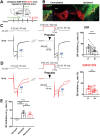Action Potential Firing Patterns Regulate Dopamine Release via Voltage-Sensitive Dopamine D2 Autoreceptors in Mouse Striatum In Vivo
- PMID: 39731325
- PMCID: PMC11831442
- DOI: 10.1002/advs.202412229
Action Potential Firing Patterns Regulate Dopamine Release via Voltage-Sensitive Dopamine D2 Autoreceptors in Mouse Striatum In Vivo
Abstract
Dopamine (DA) in the striatum is vital for motor and cognitive behaviors. Midbrain dopaminergic neurons generate both tonic and phasic action potential (AP) firing patterns in behavior mice. Besides AP numbers, whether and how different AP firing patterns per se modulate DA release remain largely unknown. Here by using in vivo and ex vivo models, it is shown that the AP frequency per se modulates DA release through the D2 receptor (D2R), which contributes up to 50% of total DA release. D2R has a voltage-sensing site at D131 and can be deactivated in a frequency-dependent manner by membrane depolarization. This voltage-dependent D2R inhibition of DA release is mediated via the facilitation of voltage-gated Ca2+ channels (VGCCs). Collectively, this work establishes a novel mechanism that APs per se modulate DA overflow by disinhibiting the voltage-sensitive autoreceptor D2R and thus the facilitation of VGCCs, providing a pivotal pathway and insight into mammalian DA-dependent functions in vivo.
Keywords: action potential; auto‐inhibition; dopamine receptor 2; dopamine release in vivo; firing pattern.
© 2024 The Author(s). Advanced Science published by Wiley‐VCH GmbH.
Conflict of interest statement
The authors declare no conflict of interest.
Figures







Similar articles
-
Increased dopamine D2 receptor activity in the striatum alters the firing pattern of dopamine neurons in the ventral tegmental area.Proc Natl Acad Sci U S A. 2015 Mar 24;112(12):E1498-506. doi: 10.1073/pnas.1500450112. Epub 2015 Feb 9. Proc Natl Acad Sci U S A. 2015. PMID: 25675529 Free PMC article.
-
Amphetamine self-administration attenuates dopamine D2 autoreceptor function.Neuropsychopharmacology. 2014 Jul;39(8):1833-42. doi: 10.1038/npp.2014.30. Epub 2014 Feb 11. Neuropsychopharmacology. 2014. PMID: 24513972 Free PMC article.
-
Inhibition of dopamine release via presynaptic D2 receptors: time course and functional characteristics in vivo.J Neurosci. 2001 Dec 1;21(23):9134-41. doi: 10.1523/JNEUROSCI.21-23-09134.2001. J Neurosci. 2001. PMID: 11717346 Free PMC article.
-
Alterations in dopamine release but not dopamine autoreceptor function in dopamine D3 receptor mutant mice.J Neurosci. 1998 Mar 15;18(6):2231-8. doi: 10.1523/JNEUROSCI.18-06-02231.1998. J Neurosci. 1998. PMID: 9482807 Free PMC article. Review.
-
Dopamine D2 autoreceptor interactome: Targeting the receptor complex as a strategy for treatment of substance use disorder.Pharmacol Ther. 2020 Sep;213:107583. doi: 10.1016/j.pharmthera.2020.107583. Epub 2020 May 27. Pharmacol Ther. 2020. PMID: 32473160 Free PMC article. Review.
References
-
- a) Mohebi A., Pettibone J. R., Hamid A. A., Wong J. T., Vinson L. T., Patriarchi T., Tian L., Kennedy R. T., Berke J. D., Nature 2019, 570, 65; - PMC - PubMed
- b) da Silva J. A., Tecuapetla F., Paixao V., Costa R. M., Nature 2018, 554, 244; - PubMed
- c) Howe M. W., Dombeck D. A., Nature 2016, 535, 505; - PMC - PubMed
- d) Liu C., Cai X., Ritzau‐Jost A., Kramer P. F., Li Y., Khaliq Z. M., Hallermann S., Kaeser P. S., Science 2022, 375, 1378. - PMC - PubMed
-
- a) Tritsch N. X., Sabatini B. L., Neuron 2012, 76, 33; - PMC - PubMed
- b) Chen Y., Gu Y., Wang B., Wei A., Dong N., Jiang Y., Liu X., Zhu L., Zhu F., Tan T., Jing Z., Mao F., Zhang Y., Yao J., Yang Y., Wang H., Wu H., Li H., Zheng C., Duan X., Huo J., Wu X., Hu S., Zhao A., Li Z., Cheng X., Qin Y., Song Q., Zhan S., Qu Q., et al., Nat. Commun. 2024, 15, 10571. - PMC - PubMed
-
- a) Wightman R. M., Robinson D. L., J. Neurochem. 2002, 82, 721; - PubMed
- b) Kiyatkin E. A., Rebec G. V., Neuroscience 1998, 85, 1285; - PubMed
- c) Hyland B. I., Reynolds J. N., Hay J., Perk C. G., Miller R., Neuroscience 2002, 114, 475; - PubMed
- d) Grace A. A., Bunney B. S., J. Neurosci. 1984, 4, 2866; - PMC - PubMed
- e) Venton B. J., Zhang H., Garris P. A., Phillips P. E., Sulzer D., Wightman R. M., J. Neurochem. 2003, 87, 1284. - PubMed
-
- a) Schultz W., Annu. Rev. Neurosci. 2007, 30, 259; - PubMed
- b) Grace A. A., Neuroscience 1991, 41, 1; - PubMed
- c) Glimcher P. W., Proc. Natl. Acad. Sci. USA 2011, 108, 15647; - PubMed
- d) Schultz W., Dayan P., Montague P. R., Science 1997, 275, 1593; - PubMed
- e) Jain S., Yee A. G., Maas J., Gierok S., Xu H., Stansil J., Eriksen J., Nelson A. B., Silm K., Ford C. P., Edwards R. H., Proc. Natl. Acad. Sci. USA 2023, 120, e2309843120. - PMC - PubMed
MeSH terms
Substances
Grants and funding
- 31930061/National Natural Science Foundation of China
- 21790394/National Natural Science Foundation of China
- 82000757/National Natural Science Foundation of China
- 31761133016/National Natural Science Foundation of China
- 31821091/National Natural Science Foundation of China
- 31330024/National Natural Science Foundation of China
- 31171026/National Natural Science Foundation of China
- 31327901/National Natural Science Foundation of China
- 32171233/National Natural Science Foundation of China
- 31670843/National Natural Science Foundation of China
- 21790390/National Natural Science Foundation of China
- 2016YFA0500401/National Key Research and Development Program of China
- 2019JC-07/Natural Science Foundation of Shanxi Province of China
- 2021TD-37/Natural Science Foundation of Shanxi Province of China
- 2023-ZDLSF-23/Natural Science Foundation of Shanxi Province of China
- BX20190012/National Postdoctoral Program for Innovative Talents
- 2020M670029/China Postdoctoral Science Foundation
LinkOut - more resources
Full Text Sources
Miscellaneous
